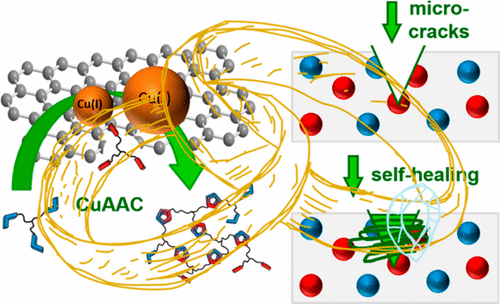当前位置:
X-MOL 学术
›
Acc. Chem. Res.
›
论文详情
Our official English website, www.x-mol.net, welcomes your feedback! (Note: you will need to create a separate account there.)
CuAAC-Based Click Chemistry in Self-Healing Polymers
Accounts of Chemical Research ( IF 18.3 ) Pub Date : 2017-09-11 00:00:00 , DOI: 10.1021/acs.accounts.7b00371 Diana Döhler 1 , Philipp Michael 1 , Wolfgang H. Binder 1
Accounts of Chemical Research ( IF 18.3 ) Pub Date : 2017-09-11 00:00:00 , DOI: 10.1021/acs.accounts.7b00371 Diana Döhler 1 , Philipp Michael 1 , Wolfgang H. Binder 1
Affiliation

|
Click chemistry has emerged as a significant tool for materials science, organic chemistry, and bioscience. Based on the initial concept of Barry Sharpless in 2001, the copper(I)-catalyzed azide/alkyne cycloaddition (CuAAC) reaction has triggered a plethora of chemical concepts for linking molecules and building blocks under ambient conditions, forming the basis for applications in autonomous cross-linking materials. Self-healing systems on the other hand are often based on mild cross-linking chemistries that are able to react either autonomously or upon an external trigger. In the ideal case, self-healing takes place efficiently at low temperatures, independent of the substrate(s) used, by forming strong and stable networks, binding to the newly generated (cracked) interfaces to restore the original material properties. The use of the CuAAC in self-healing systems, most of all the careful design of copper-based catalysts linked to additives as well as the chemical diversity of substrates, has led to an enormous potential of applications of this singular reaction. The implementation of click-based strategies in self-healing systems therefore is highly attractive, as here chemical (and physical) concepts of molecular reactivity, molecular design, and even metal catalysis are connected to aspects of materials science. In this Account, we will show how CuAAC reactions of multivalent components can be used as a tool for self-healing materials, achieving cross-linking at low temperatures (exploiting concepts of autocatalysis or internal chelation within the bulk CuAAC and systematic optimization of the efficiency of the used Cu(I) catalysts). Encapsulation strategies to separate the click components by micro- and nanoencapsulation are required in this context. Consequently, the examples reported here describe chemical concepts to realize more efficient and faster click reactions in self-healing polymeric materials. Thus, enhanced chain diffusion in (hyper)branched polymers, autocatalysis, or internal chelation concepts enable efficient click cross-linking already at 5 °C with a simultaneously reduced amount of Cu(I) catalyst and increased reaction rates, culminating in the first reported self-healing system based on click cycloaddition reactions. Via tailor-made nanocarbon/Cu(I) catalysts we can further improve the click cross-linking reaction in view of efficiency and kinetics, leading to the generation of self-healing graphene-based epoxy nanocomposites. Additionally, we have designed special CuAAC click methods for chemical reporting and visualization systems based on the detection of ruptured capsules via a fluorogenic click reaction, which can be combined with CuAAC cross-linking reactions to obtain simultaneous stress detection and self-healing within polymeric materials. In a similar concept, we have prepared polymeric Cu(I)–biscarbene complexes to detect (mechanical) stress within self-healing polymeric materials via a triggered fluorogenic reaction, thus using a destructive force for a constructive chemical response.
中文翻译:

自修复聚合物中基于CuAAC的点击化学
点击化学已成为材料科学,有机化学和生物科学的重要工具。基于2001年Barry Sharpless的最初概念,铜(I)催化的叠氮化物/炔烃环加成(CuAAC)反应引发了许多化学概念,这些化学概念用于在环境条件下连接分子和结构单元,为自主应用奠定了基础。交联材料。另一方面,自我修复系统通常基于温和的交联化学物质,能够自发地或在外部触发条件下发生反应。在理想情况下,通过形成牢固而稳定的网络,并结合到新生成的(破裂的)界面上以恢复原始材料的性能,可以在低温下有效地进行自我修复,而与所使用的基材无关。在自愈系统中使用CuAAC,最重要的是精心设计与添加剂连接的铜基催化剂,以及底物的化学多样性,使这种奇异反应具有巨大的应用潜力。因此,在自愈系统中实施基于点击的策略非常具有吸引力,因为此处分子反应性,分子设计甚至金属催化的化学(和物理)概念都与材料科学的各个方面联系在一起。在此帐户中,我们将展示如何将多价组分的CuAAC反应用作自修复材料的工具,在低温下实现交联(利用本体CuAAC中的自动催化或内部螯合概念以及对效率的系统优化)所用的Cu(I)催化剂的数量)。在这种情况下,需要通过微囊化和纳米囊化来分离点击成分的囊化策略。因此,此处报道的示例描述了化学概念,可实现自愈聚合物材料中更有效,更快的点击反应。因此,在(超)支化聚合物中增强的链扩散,自动催化或内部螯合概念可在5°C的温度下实现有效的点击交联,同时减少Cu(I)催化剂的量并提高反应速率,最终在首次报道时达到顶峰基于点击环加成反应的自我修复系统。通过定制的纳米碳/ Cu(I)催化剂,我们可以根据效率和动力学进一步改善点击交联反应,从而导致产生自修复的石墨烯基环氧纳米复合材料。此外,我们基于通过荧光点击反应检测破裂的胶囊,为化学报告和可视化系统设计了特殊的CuAAC点击方法,可以将其与CuAAC交联反应结合使用,从而在聚合物材料中同时进行压力检测和自我修复。在类似的概念中,我们准备了聚合的Cu(I)-双卡宾配合物,通过触发的荧光反应来检测自愈的聚合材料中的(机械)应力,从而利用破坏力进行了建设性的化学反应。可以与CuAAC交联反应结合使用,从而在聚合物材料中同时进行应力检测和自我修复。在类似的概念中,我们准备了聚合的Cu(I)-双卡宾配合物,通过触发的荧光反应来检测自愈的聚合材料中的(机械)应力,从而利用破坏力进行了建设性的化学反应。可以与CuAAC交联反应结合使用,从而在聚合物材料中同时进行应力检测和自我修复。在类似的概念中,我们准备了聚合的Cu(I)-双卡宾配合物,通过触发的荧光反应来检测自愈的聚合材料中的(机械)应力,从而利用破坏力进行了建设性的化学反应。
更新日期:2017-09-11
中文翻译:

自修复聚合物中基于CuAAC的点击化学
点击化学已成为材料科学,有机化学和生物科学的重要工具。基于2001年Barry Sharpless的最初概念,铜(I)催化的叠氮化物/炔烃环加成(CuAAC)反应引发了许多化学概念,这些化学概念用于在环境条件下连接分子和结构单元,为自主应用奠定了基础。交联材料。另一方面,自我修复系统通常基于温和的交联化学物质,能够自发地或在外部触发条件下发生反应。在理想情况下,通过形成牢固而稳定的网络,并结合到新生成的(破裂的)界面上以恢复原始材料的性能,可以在低温下有效地进行自我修复,而与所使用的基材无关。在自愈系统中使用CuAAC,最重要的是精心设计与添加剂连接的铜基催化剂,以及底物的化学多样性,使这种奇异反应具有巨大的应用潜力。因此,在自愈系统中实施基于点击的策略非常具有吸引力,因为此处分子反应性,分子设计甚至金属催化的化学(和物理)概念都与材料科学的各个方面联系在一起。在此帐户中,我们将展示如何将多价组分的CuAAC反应用作自修复材料的工具,在低温下实现交联(利用本体CuAAC中的自动催化或内部螯合概念以及对效率的系统优化)所用的Cu(I)催化剂的数量)。在这种情况下,需要通过微囊化和纳米囊化来分离点击成分的囊化策略。因此,此处报道的示例描述了化学概念,可实现自愈聚合物材料中更有效,更快的点击反应。因此,在(超)支化聚合物中增强的链扩散,自动催化或内部螯合概念可在5°C的温度下实现有效的点击交联,同时减少Cu(I)催化剂的量并提高反应速率,最终在首次报道时达到顶峰基于点击环加成反应的自我修复系统。通过定制的纳米碳/ Cu(I)催化剂,我们可以根据效率和动力学进一步改善点击交联反应,从而导致产生自修复的石墨烯基环氧纳米复合材料。此外,我们基于通过荧光点击反应检测破裂的胶囊,为化学报告和可视化系统设计了特殊的CuAAC点击方法,可以将其与CuAAC交联反应结合使用,从而在聚合物材料中同时进行压力检测和自我修复。在类似的概念中,我们准备了聚合的Cu(I)-双卡宾配合物,通过触发的荧光反应来检测自愈的聚合材料中的(机械)应力,从而利用破坏力进行了建设性的化学反应。可以与CuAAC交联反应结合使用,从而在聚合物材料中同时进行应力检测和自我修复。在类似的概念中,我们准备了聚合的Cu(I)-双卡宾配合物,通过触发的荧光反应来检测自愈的聚合材料中的(机械)应力,从而利用破坏力进行了建设性的化学反应。可以与CuAAC交联反应结合使用,从而在聚合物材料中同时进行应力检测和自我修复。在类似的概念中,我们准备了聚合的Cu(I)-双卡宾配合物,通过触发的荧光反应来检测自愈的聚合材料中的(机械)应力,从而利用破坏力进行了建设性的化学反应。


























 京公网安备 11010802027423号
京公网安备 11010802027423号